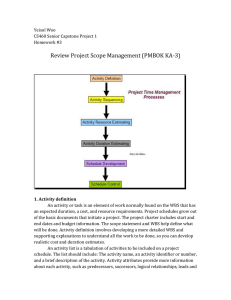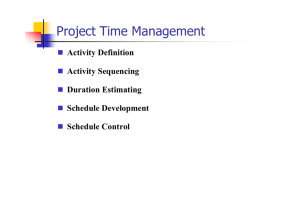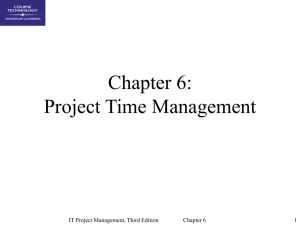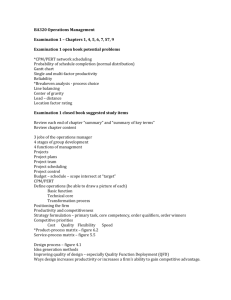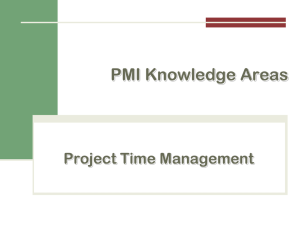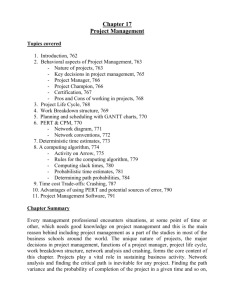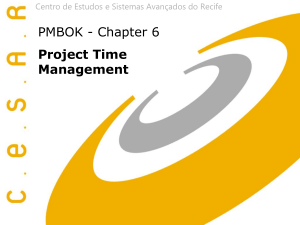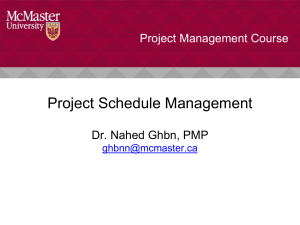LECTURE 23
advertisement
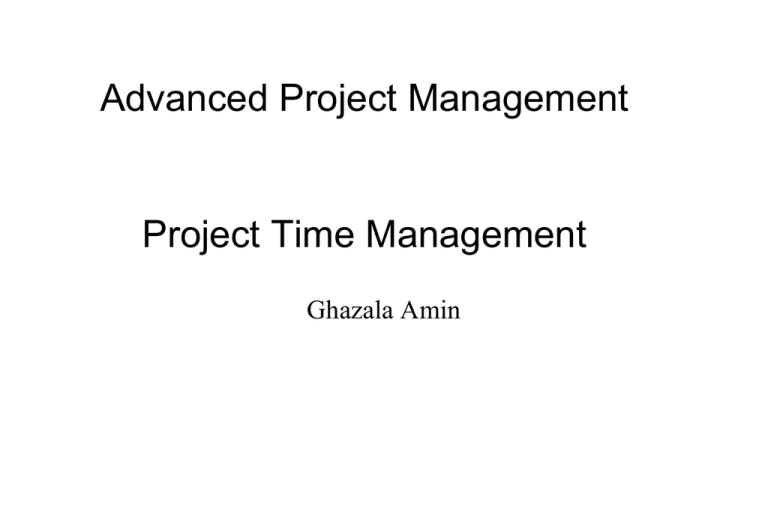
Advanced Project Management Project Time Management Ghazala Amin Project Time Management • Reference study materials – A guide to the Project Management Body of Knowledge (PMBOK Guide), Chapter 6 – Study notes – Dr. Kerzner’s book, Chapter 12 2 Project Parameters: Time All projects have a life span, namely, the interval between the point in time the project formally commences and the point in time when it is completed or prematurely terminated. The project life-span can range from very short - for e.g., one week for recataloguing books in a public library - to very long, for e.g., eight years for the construction of a large dam with attached electric power generating station. As with cost, it is often difficult to determine the life-span of a project with a high level of accuracy, especially in the pro-ject‘s early stages. Schedule overruns are common in pro-jects and, like cost overruns, they too are also considered a manifestation of project failure. 3 Project Parameters: Time (Important Topics in Project Time Management) Project Activities Dependency Relationships Between Project Activities Project Activity Duration Estimation Project Milestones Project Schedule Baseline Project Gantt Charts Network Diagrammes (Arrow-on-Arrow, Arrow-on-Node) Critical Path Method Programme Evaluation Review Technique “Crashing“ the Project Earned Value Method Time Management Training for Project Staff 4 PMBOK Area: Time Management Project Time Management includes the processes required to ensure the completion of the project within the time-frame which has been allocated for it. Processes covered under Project Time Management are activity definition, activity resource estimating, activity duration estimating, schedule development, and schedule control. 5 Project Time Management • Includes the processes required to ensure timely completion of the project • Enables effective management of time and resources assigned to project tasks 6 Project Time Management • Poor time management is caused by – difficulty in saying no – lack of self discipline – bureaucracy – lack of delegation – poor utilization of staff 7 Project Time Management - Processes Project Time Management processes (per PMBOK) Define Activities Sequence Activities Estimate Activity Resources Estimate Activity Duration Develop Schedule Control Schedule Process Groups Initiation Planning Execution Control Closing Knowledge Areas Time Management Define Activities Schedule Control Sequence Activities Estimate Activity Resources Estimate Activity Duration Develop Schedule 8 Activity Definition • Involves identifying and documenting the specific activities that must be performed in order to produce the deliverables and subdeliverables identified in the work breakdown structure 9 Activity Definition • Work breakdown structure is reviewed. • Any additional Constraints and assumptions are identified • Expert judgment of staff or SMEs are procured • Results in; – Finalized Activity list for project delivery – Work breakdown structure updates are made if needed. 10 Activity Sequencing • Involves identifying and documenting interactivity logical relationships. Activities must be sequenced accurately to support later development of a realistic and achievable schedule 11 Activity Sequencing • • • • • • Activity list is finalized. Mandatory dependencies are identified Discretionary dependencies are identified External dependencies are identified Milestones are identified Common Tools & Techniques used are; • Precedence Diagramming Method (PDM) • Arrow Diagramming Method (ADM) • Results in; – Project network diagram – Schematic Display of project activities and logical relationships among them. (Eg. ADM, PDM) – Activities will get further decomposed and redefined after establishing logical relationships. 12 Activity Sequencing • Precedence Diagramming Method (PDM) – Nodes represent activities – Arrows connect activities and show dependencies – Also referred to as Activity-on-Node (AON) – Uses four type of dependencies: • Finish-to-start, finish-to-finish, start-to-start, start-tofinish Activity (A) Activity (B) 13 Activity Sequencing • Arrow Diagramming Method (ADM) – Arrows represent activities – Connected at nodes showing dependencies – Also referred to as Activity-on-Arrow (AOA) – Uses only finish-to-start dependencies – May use dummy activity Activity 14 Project Network Diagram – Example 6/7 7/27 7/28 9/6 Mileage (5,10&15) CUPID Unload 6/7 6/23 Dealer Unload 5/22 6/2 Design Trans. 9/7 6/7 6/27 Dealer (16) 6/28 8/8 Suppression Contact History (6&7) 8/1 6/7 Dealer (18.1 & 18.2) PIT Handoff 8/2 10/27 10/30 PIT Testing 8/23 8/9 9/11 Code Freeze CKS R2 Launch 8/18 PMC 15 Resource Planning • Involves determining physical resources and the quantities required to perform project activities – People – Facilities – Equipment – Material 16 Activity Duration Estimating – Involves assessing the number of work periods likely to be needed to complete each identified activity 17 Activity Duration Estimating • • • • • • • Activity list is further reviewed and finalized Any additional Constraints and assumptions are identified Resource requirements/capabilities are defined All Historical information is retrieved for estimating Identified Risks with estimation is documented. Expert judgment is used for time estimation Reserve time (Contingency) is built in as risk mitigation • Results in; – Activity duration estimates – Activity list updates 18 Schedule Development – Schedule development means determining start and finish dates for project activities 19 Schedule Development • Project Management Software is most commonly used for schedule development. • Leads and lags are identified for tasks; – Lead: A modification of a logical relationship which allows an acceleration of the successor task – Lag: A modification of a logical relationship which directs a delay in the successor task • Resource pool description • Calendars and work hours are updated 20 Schedule Development • Mathematical Analysis used commonly; • Critical Path Method (CPM) • Graphical Evaluation and Review Technique (GERT) • Program Evaluation and Review Technique (PERT) – Duration Compression • Crashing • Fast Tracking – Simulation • Monte Carlo 21 Schedule Development • Critical Path Method (CPM) – Determines early and late start and finish date for each activity – Calculate float – Find least flexible activities 22 Schedule Development • Program Evaluation and Review Technique (PERT) – Uses weighted Average duration estimates – PERT uses mean instead of Most Likely estimate used by CPM • Pert Calculations – O = Optimistic – P = Pessimistic – M = Most likely – Weighted duration = (O+4M+P)/6 23 Schedule Development • Crashing – Maximum amount of compression for minimum additional cost • Fast tracking – Overlapping serial activities 24 Schedule Control • Schedule control is concerned with – (a) influencing the factors which create schedule changes to ensure that changes are beneficial, – (b) determining that the schedule has changed, – (c) managing the actual changes when and as they occur 25 Schedule Control • Project schedule is updated with actual • Change requests are reviewed and added to schedule • Project Management software is used for updates • Results in; – Schedule updates – Documentation of Corrective actions and lessons learned. 26 Schedule Management Plan – Plan for how the schedule changes will be managed – Plan for change control process and procedures, performance measures – This will be part of Project Plan 27
